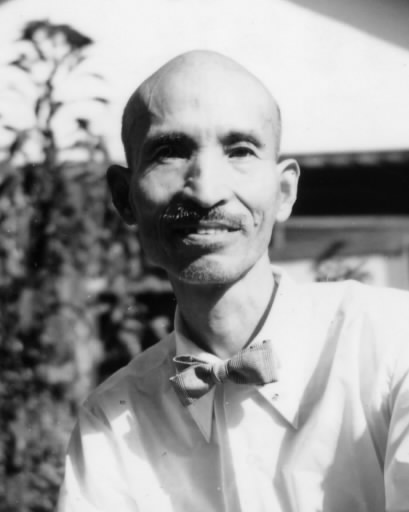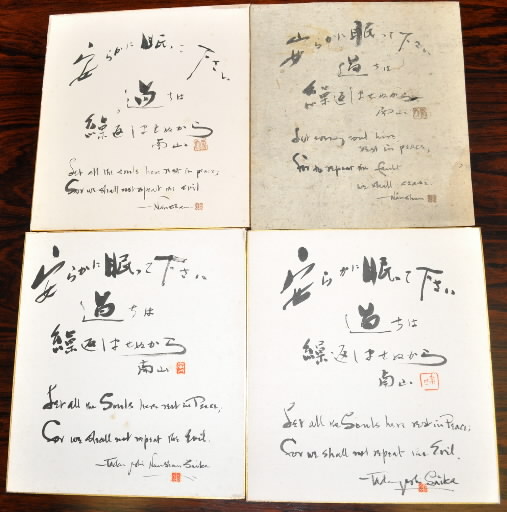Original writings for inscription on A-bomb cenotaph are found
May 25, 2010
by Kana Kobayashi, Staff Writer
Four pieces of writing by Tadayoshi Saika, the former Hiroshima University professor who conceived the inscription engraved on the Cenotaph for the A-bomb Victims in Hiroshima Peace Memorial Park, have been found at a private residence in Nishi Ward, Hiroshima. All four writings by Mr. Saika (1894-1961) show the original inscription in Japanese as well as the English translation. The translation, in fact, is written in two ways, prompting an official of the Hiroshima Municipal Archives to praise the find, saying, "These are valuable materials that reveal Professor Saika's strong feelings for English translation."
"Yasurakani nemutte kudasai. Ayamachi wa kurikaeshimasenukara." ("Let all the souls here rest in peace; for we shall not repeat the evil.") The phrase in 21 Japanese characters, created by Professor Saika to embody the prayers and commitment of humanity, was handwritten on a piece of paper and on three cards, 27 centimeters long and 24 centimeters wide. The Japanese phrases are written in three horizontal lines, like the inscription on the Cenotaph, with the English translation below. The piece of paper bears a translation that is different from the official translation now on the Cenotaph.
Tsuneo Sato, 76, head of a medical corporation, found the writings at the end of April when he was sorting out a drawer at his home. Professor Saika had presented the writings to Fumi Sato, Mr. Sato's mother, who passed away in 1989. Apparently, Professor Saika and Fumi Sato had been friends and she received the writings in the early 1950s.
On the paper, the latter half of the phrase is translated as: "For to repeat the fault we shall cease." Around July 1952 this translation was announced as the inscription for the Cenotaph by the City of Hiroshima.
Afterwards, however, Professor Saika, who specialized in English literature, continued to examine the English translation in various ways, which included seeking comments from academics in the United States.
On the cards, the official and more natural-sounding phrase is written: "For we shall not repeat the evil." This translation finally became the official inscription for the Cenotaph.
In November 1952, the "inscription debate" emerged. Radhabinod Pal, an international law scholar from India, visited Hiroshima and, standing before the Cenotaph, listened to an explanation about the inscription from an interpreter. Dr. Pal then questioned why "the Japanese" were also indicated in the subject "we," touching off the dispute.
Professor Saika argued against Dr. Pal's interpretation, saying, "The inscription is a commitment by all of us, the citizens of the world, before the souls of the dead." He sent Dr. Pal a letter affirming this view and adding the text of the official translation, which had already been formally recognized. His actions show how Professor Saika took pride in his reworking of the English translation.
Upon the request made by the Hiroshima Municipal Archives, Mr. Sato agreed to donate Professor Saika's writings. Kazuhiko Takano, director of the Archives, commented, "I had never seen the early translation of the phrase originally written by Professor Saika. The Archives will preserve these materials with great care and will share them with the public at an early date."
(Originally published on May 24, 2010)
Four pieces of writing by Tadayoshi Saika, the former Hiroshima University professor who conceived the inscription engraved on the Cenotaph for the A-bomb Victims in Hiroshima Peace Memorial Park, have been found at a private residence in Nishi Ward, Hiroshima. All four writings by Mr. Saika (1894-1961) show the original inscription in Japanese as well as the English translation. The translation, in fact, is written in two ways, prompting an official of the Hiroshima Municipal Archives to praise the find, saying, "These are valuable materials that reveal Professor Saika's strong feelings for English translation."
"Yasurakani nemutte kudasai. Ayamachi wa kurikaeshimasenukara." ("Let all the souls here rest in peace; for we shall not repeat the evil.") The phrase in 21 Japanese characters, created by Professor Saika to embody the prayers and commitment of humanity, was handwritten on a piece of paper and on three cards, 27 centimeters long and 24 centimeters wide. The Japanese phrases are written in three horizontal lines, like the inscription on the Cenotaph, with the English translation below. The piece of paper bears a translation that is different from the official translation now on the Cenotaph.
Tsuneo Sato, 76, head of a medical corporation, found the writings at the end of April when he was sorting out a drawer at his home. Professor Saika had presented the writings to Fumi Sato, Mr. Sato's mother, who passed away in 1989. Apparently, Professor Saika and Fumi Sato had been friends and she received the writings in the early 1950s.
On the paper, the latter half of the phrase is translated as: "For to repeat the fault we shall cease." Around July 1952 this translation was announced as the inscription for the Cenotaph by the City of Hiroshima.
Afterwards, however, Professor Saika, who specialized in English literature, continued to examine the English translation in various ways, which included seeking comments from academics in the United States.
On the cards, the official and more natural-sounding phrase is written: "For we shall not repeat the evil." This translation finally became the official inscription for the Cenotaph.
In November 1952, the "inscription debate" emerged. Radhabinod Pal, an international law scholar from India, visited Hiroshima and, standing before the Cenotaph, listened to an explanation about the inscription from an interpreter. Dr. Pal then questioned why "the Japanese" were also indicated in the subject "we," touching off the dispute.
Professor Saika argued against Dr. Pal's interpretation, saying, "The inscription is a commitment by all of us, the citizens of the world, before the souls of the dead." He sent Dr. Pal a letter affirming this view and adding the text of the official translation, which had already been formally recognized. His actions show how Professor Saika took pride in his reworking of the English translation.
Upon the request made by the Hiroshima Municipal Archives, Mr. Sato agreed to donate Professor Saika's writings. Kazuhiko Takano, director of the Archives, commented, "I had never seen the early translation of the phrase originally written by Professor Saika. The Archives will preserve these materials with great care and will share them with the public at an early date."
(Originally published on May 24, 2010)









